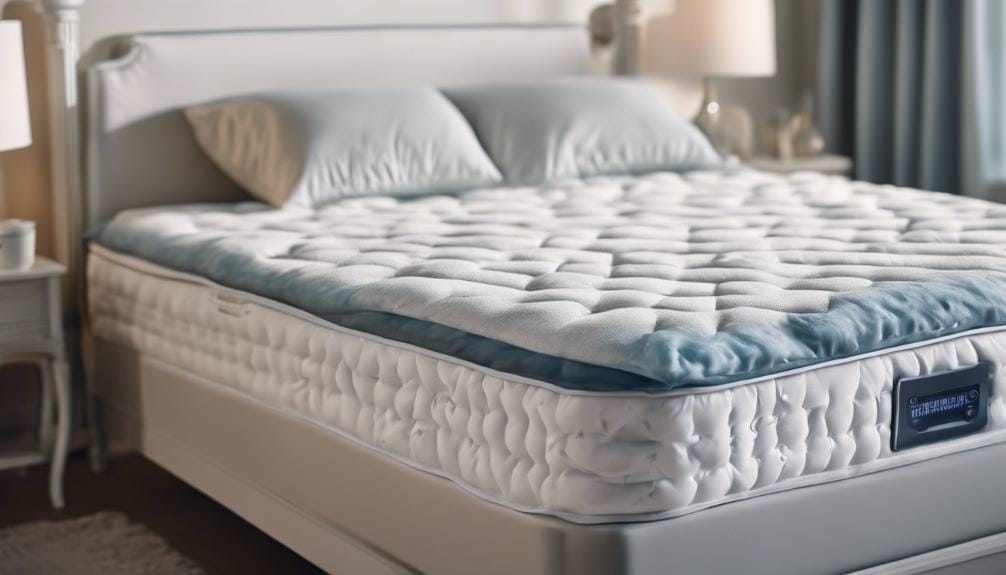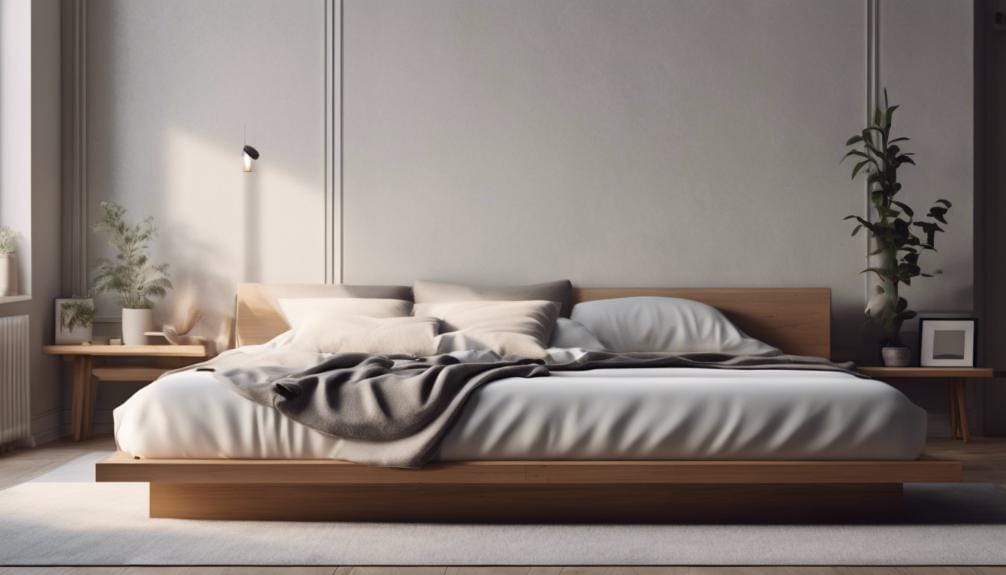Can You Sleep on a Mattress Topper? A Comprehensive Guide
You can definitely sleep on a mattress topper, enhancing your overall sleeping experience. It provides extra comfort and support while prolonging your mattress’s lifespan. Plus, it’s a cost-effective way to improve sleep quality by regulating body temperature and reducing allergens. If you want more details on the benefits of using mattress toppers, different types to explore, and how they can assist with allergies and chronic pain, keep exploring!
Benefits of Sleeping on a Mattress Topper
Sleeping on a mattress topper can boost your bed’s comfort and support. These toppers add extra cushioning, making your sleep more comfortable. They’re useful in various temporary situations such as camping, hosting guests overnight, or while waiting for a new mattress. However, mattress toppers aren’t designed for long-term use as they don’t provide the same support and durability as regular mattresses. It’s important to consider your personal comfort preferences, health requirements, and the level of comfort you need when using a mattress topper. Utilize this additional layer to achieve a more restful and supportive sleep.
Keep in mind that mattress toppers come in different materials like memory foam, latex, and feather. Each material has its pros and cons. For example, memory foam molds to your body shape, providing excellent support but can retain heat. Latex offers firm support and is cooling but may be too firm for some. Feather toppers are very soft and enhance comfort but may not provide enough support for those with back issues. Choose the type that best meets your needs.
Maintain your mattress topper properly to extend its life. Regular cleaning and airing out can help prevent the buildup of allergens and maintain its comfort features. Remember, a well-cared-for mattress topper can significantly enhance your sleeping experience, even if it’s just for a short while.
Types of Mattress Toppers to Consider
When choosing a mattress topper, consider the various types available that suit your specific requirements. If you need elasticity, antibacterial properties, and hypoallergenic benefits, opt for a latex mattress topper.
Memory foam mattress toppers are good for pain relief and conforming to your body shape, though they may emit a chemical smell initially.
Polyester blend mattress toppers provide softness but might lose their shape quicker. Feather mattress toppers are soft and fluffy, yet they may flatten over time and aggravate allergies.
Select a topper that provides the right level of firmness and support for your needs, especially if you often feel hot while sleeping or if you have conditions like back pain, chronic pain, or mobility issues.
How Mattress Toppers Aid Allergies

If you suffer from allergies, particularly respiratory ones, a mattress topper can be a valuable addition to your bedding. Dust mites and mold, which thrive in moist and poorly ventilated environments, often accumulate in mattress toppers. These allergens can exacerbate respiratory conditions and other allergy symptoms. So, choosing a mattress topper made from hypoallergenic materials can significantly reduce your exposure to these irritants.
To maintain a healthier sleeping environment, ensure your sleeping area is well-ventilated. This helps prevent the buildup of dust mites and mold. Remember, if your allergies worsen or persist, seek advice from a healthcare provider.
Using allergy-friendly bedding can enhance your sleep quality and overall health. By focusing on hypoallergenic materials and proper ventilation, you create a bedroom that supports your needs and helps keep allergens at bay.
Addressing Chronic Pain With Mattress Toppers
To manage chronic pain more effectively, adding a supportive mattress topper to your bed can be beneficial. Toppers made from memory foam or latex are particularly good at easing pressure points and aligning your spine correctly. These features are crucial for people suffering from conditions like arthritis or fibromyalgia. Before deciding on a mattress topper, do consult with a healthcare provider to identify the best option tailored to your needs.
Controlling Temperature With Mattress Toppers

A mattress topper can help manage chronic pain and control your sleeping temperature. To keep your sleep cool and comfortable, choose a mattress topper made from breathable materials such as latex or gel-infused memory foam. These materials allow air to flow freely, which helps prevent overheating or feeling too cold during the night. Remember to consider your personal comfort temperature when picking a mattress topper.
Proper ventilation around the mattress topper is crucial for maintaining an even temperature throughout the night. By selecting a mattress topper that supports temperature regulation, you ensure a more uninterrupted and restful sleep, free from discomfort caused by extreme temperatures.
Mattress Toppers for Travel and Budgeting
Mattress toppers are practical for travel or when money is tight. They’re affordable and suitable for short-term use, perfect for camping or when you have extra guests. Although they’re a temporary solution, mattress toppers still offer important support and comfort, helping you sleep well. If you’re waiting for a new mattress or prefer a simple setup, consider a mattress topper. They’re easy to move and set up, making them a popular choice for those looking for an effective, low-cost bedding solution.
Use a mattress topper for your next trip or when you need a cost-effective sleep option. They can easily fit into various living situations without breaking the bank. Remember, mattress toppers aren’t just for guests or travel. They can also improve the comfort of an aging mattress, extending its life until you can afford a new one.
There are many types of mattress toppers: foam, feather, and fiber are just a few examples. Foam toppers are popular because they provide good support by molding to your body. Feather toppers are softer and provide a luxurious feel but mightn’t offer the same level of support as foam. Fiber toppers are usually hypoallergenic and are a good option for those with allergies.
Investing in a mattress topper can be a wise decision for both comfort and budget. They’re a smart way to manage your sleeping arrangements without spending a lot of money.
Incorporating Mattress Toppers in a Minimalist Lifestyle

Opting for a mattress topper can simplify your bedding needs and support a minimalist lifestyle. By placing a mattress topper directly on the floor, you eliminate the need for a bulky bed frame, freeing up space in your room. This choice not only saves space but also cuts costs, making it a practical option for budget-conscious individuals.
For a more tailored sleeping experience, consider creating a DIY mattress from toppers. This approach allows you to customize the firmness and support according to your personal preferences. When selecting a mattress topper, look for eco-friendly materials like organic latex or bamboo. These sustainable options align with the minimalist goal of reducing environmental impact.
Using mattress toppers in this way enhances your sleep environment while keeping in line with minimalist principles. Remember, the key is to focus on what’s essential, reducing clutter and simplifying your living space.
Maximizing Comfort and Support With Mattress Toppers
To maximize comfort and support with mattress toppers, it’s crucial to tailor choices to your individual sleep needs and preferences. Here are four practical tips to help you sleep better:
- Choose the Right Thickness: Opt for a mattress topper that aligns with your comfort preferences while providing adequate support. A thicker topper might be ideal if you prefer a softer feel, while a thinner one could suffice if support is your main concern.
- Focus on Material: Select a topper material that complements your sleep style. For example, memory foam is great for those who like comfort that molds to their body, whereas latex offers a bouncier, more responsive feel.
- Address Back and Joint Pain: Find a topper designed to ease back or joint pain. These typically have features like extra support zones or pressure-relieving materials.
- Balance Comfort and Budget: Invest in a quality mattress topper that meets your comfort needs without straining your finances. There’s no need to overspend to achieve a restful night’s sleep.
Frequently Asked Questions
Is It OK to Sleep on Mattress Topper?
Sleeping on a mattress topper may provide temporary comfort, but for prolonged use, it lacks essential support, potentially causing back and joint pain. Opt for a proper mattress to maintain spinal alignment and promote better sleep posture.
Can You Sleep on a Mattress Topper Without a Sheet?
You should always use a sheet when sleeping on a mattress topper. Direct contact can cause quicker wear and expose it to dirt and sweat. Using a sheet maintains cleanliness, hygiene, and adds extra comfort.
Can You Sleep on a Mattress Topper Before 24 Hours?
Yes, you should wait 24 hours before sleeping on a mattress topper for best expansion and support. Using it before that may impact its comfort and support level, leading to potential discomfort. Follow the manufacturer’s instructions for best results.
Can You Use Mattress Topper as Floor Mattress?
You can definitely use a mattress topper as a floor mattress. It’s a budget-friendly option. Consider allergies and seek advice for chronic pain. Check floor temperature and cleanliness for comfort. Different types like memory foam, latex, and feather can be used.
Conclusion
Can you sleep on a mattress topper?
Yes, you can!
Mattress toppers can make your bed more comfortable.
They add extra support and might even help with allergies and chronic pain.
If you want to upgrade your mattress, take a comfortable bed on a trip, or save money, a mattress topper is a good choice.
Try using one to see how it improves your sleep.
